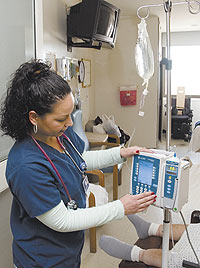  |
| HOME | THIS ISSUE | CALENDAR | GRANTS | BACK ISSUES | < BACK | NEXT > |
Hospital’s safety project demonstrates progressby Jane Shaskan - December 12, 2005
|
||||
|
Pocket guides for managing pain, “smart pumps” to dispense medicine, more dispensers for antibacterial gel, and better ways to predict which patients are at risk for falls – all are improvements to the care at John Dempsey Hospital planned or undertaken in the past year. These changes, and others, are part of a project called the Collaborative Center for Clinical Care Improvement, created in 2004 to make John Dempsey the safest hospital in the state. The project’s leaders recently discussed its progress with the Health Center community. In the area of pain management, a pocket guide was compiled to provide information about doses, conversions, and recommendations for drug choices. “We queried other hospitals to be sure our pain treatment guidelines were consistent, and then created an institution-wide pain pocket guide for all consortium residents and physicians,” says Dr. Joseph Civetta, professor and vice chairman of the Department of Surgery, the pain management group leader. A subgroup also conducted a small pilot study, assessing 32 surgical patients in a six-month period. “The group found that there are many opportunities to do better in the area of pain documentation and reassessment,” Civetta says. “Revision of our recording and management procedures is planned.” The medication safety group, led by Lisa Jaser, director of pharmacy, has implemented “smart pumps” that monitor infusions, an automated medication dispensing system, and a medication assessment tool. “Our first pass at the assessment, which includes 199 questions relating to patient information, drug information and standardization, communication, environment, and staff, showed we were 40 percent implemented in all areas,” says Jaser. “This is really quite remarkable. It’s a good measure of where we are and where we need to be.” The group has also identified, and eliminated, any medical abbreviations that could cause confusion, and implemented a bar code medication packing system, the first step in a point-of-care system designed to automate, track, and assure the quality of the medication use process. The number of patient falls has decreased, says Rhea Sanford, director of performance improvement and patient safety and fall reduction leader. “It is an unrealistic goal to have no occurrences,” she says. “Our goal is no serious injuries.” The group has been focusing on the development and implementation of a fall assessment tool to identify quickly those patients at risk for a fall. The group also evaluated and replaced hospital beds and patient lift equipment. Sanford says the next focus will be on the assessment of delirium in patients, which she explains can contribute to falls. “By treating the symptoms and reversing delirium, we can decrease the patient’s risk of falling, which will allow the patient mobility, an important part of recovery,” she says.
Dr. Richard Garibaldi, chairman of the Department of Medicine and leader of the infection control group, says “We want the prevention of hospital acquired infections to be such an important part of our culture that these types of infections will not be tolerated.” The group stresses flu immunizations and hand washing which, Garibaldi explains, will result in less employee absenteeism and a lower risk for infection to patients. “More sinks, and waterless sanitizer dispensers outside patient rooms, have been added to improve hand washing compliance,” he says. Currently, the compliance rate after patient contact is 48 percent; the goal is to bring it up to 75 percent. In the area of catheter-associated infections, Garibaldi says the group continues to work on identifying risk factors and modifying protocols, equipment, and techniques to reduce the rates of infection to what he calls “an irreducible minimum.” The goal is “to build an infection control program that will be a model for others to follow,” he adds. As part of the strategy for cultural assessment and change, a survey was sent to more than 4,600 Health Center employees late last spring to evaluate how they perceived the quality of their work life, says culture change leader Nick Warren, assistant professor of medicine and director of the Ergonomics Center. More than 1,400 people responded. The responses include the belief that work done at the Health Center is important and that senior leadership is committed to the values of diversity. Discrimination is perceived in the area of opportunity for advancement by many from diverse backgrounds, and women reported being treated less fairly than men. And many managers were perceived as lacking effective team-building skills. Managers and administrators have been directed by senior administration to share survey results within their departments and generate suggestions for corrective actions. “We are creating focus groups to get a better understanding of the survey results and identify areas for change,” says Warren. The focus groups, he explained, will explore teamwork, justice and equity issues, rewards and recognition, control, and feedback. The survey was sponsored by senior administration and was funded by the Connecticut Health Foundation. There will be a follow-up survey next year. “An enormous amount of work has gone into our patient safety initiative,” says Dr. Steven Strongwater, director of the John Dempsey Hospital. “It’s important that we effect a culture of safety in each and every one of us.” |
| ADVANCE HOME UCONN HOME |

